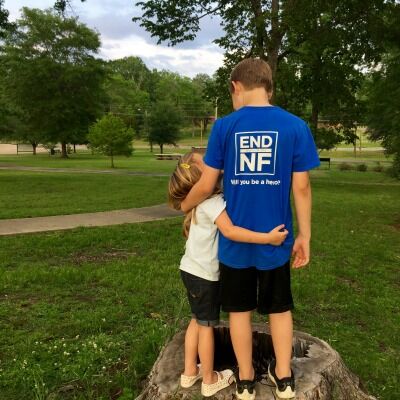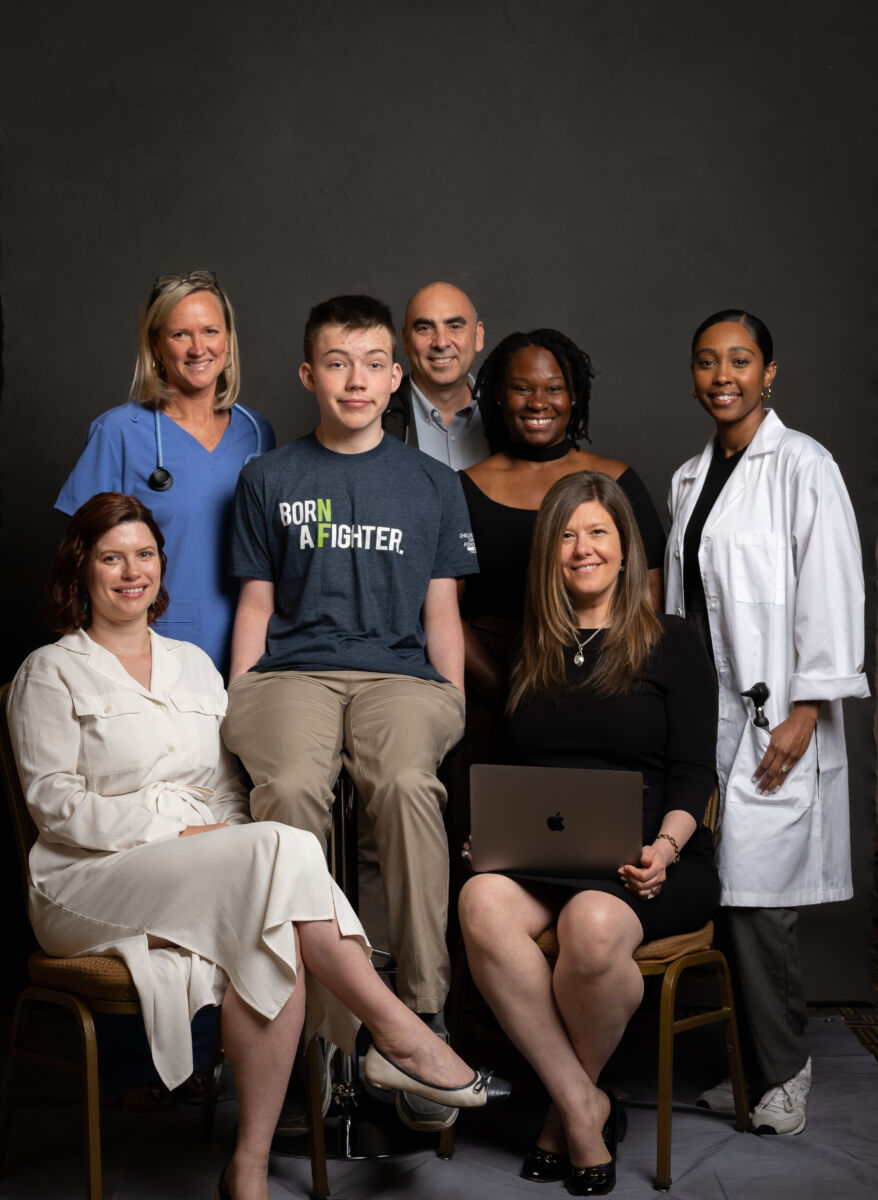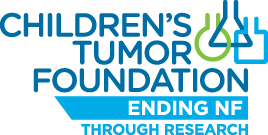Answering questions and shedding light on neurofibromatosis and schwannomatosis
What is NF?
NF refers to a group of genetic conditions that cause tumors to grow on nerves throughout the body. NF includes neurofibromatosis type 1 (NF1) and all types of schwannomatosis (SWN), including NF2-related schwannomatosis (NF2-SWN), formerly known as neurofibromatosis type 2, or NF2. NF impacts everyone differently and may lead to blindness, deafness, bone abnormalities, disfigurement, learning challenges, disabling pain, or cancer.
What is neurofibromatosis?
Neurofibromatosis is a term that was previously used to refer to a number of genetic conditions that we now call by their distinctive names. Today, the abbreviation “NF” can be used to collectively to the group of disorders that cause tumors to grow on nerves. NF includes neurofibromatosis type 1 (NF1) and all types of schwannomatosis (SWN), including NF2-related schwannomatosis (NF2-SWN), formerly known as neurofibromatosis type 2, or NF2. People sometimes use the word neurofibromatosis to refer to neurofibromatosis type 1, however, to avoid confusion, it is more correct to refer to the condition as neurofibromatosis type 1, or NF1.
How many people does NF affect?
NF affects approximately 1 in every 2,000 births, affecting approximately 4 million people worldwide. Anyone can be born with NF, and it affects all genders, races, and ethnicities equally.
- Neurofibromatosis type 1 (NF1) occurs in approximately 1 in every 2,500 births.
- NF2-related schwannomatosis (NF2-SWN) occurs in approximately 1 in 25,000 births.
- SWN (excluding NF2-SWN) occurs in approximatley 1 in 70,000 births.

Is there a cure for NF?
Currently, there is no cure for NF, but research spearheaded by the Children’s Tumor Foundation is accelerating the path to more treatment options for all types of NF, and eventually, a cure.
Significantly, there are now two drugs approved by the Food and Drug Administration (FDA) for NF, Koselugo (selumetinib) and Gomekli (mirdametinib), for use in patients with inoperable plexiform neurofibromas, a common manifestation in neurofibromatosis type 1 (NF1). See “What are treatment options?” in the FAQ below.
The groundbreaking use of MEK inhibitors (selumetinib and mirdametinib) as a treatment for NF tumors began with early-stage discoveries funded by the Children’s Tumor Foundation (CTF). CTF-supported researchers were the first to demonstrate that MEK inhibitors could significantly reduce NF tumor size—paving the way for a revolutionary shift in NF treatment.
CTF also invested in a clinical trial for NFX-179, a topical gel for cutaneous neurofibromas that is showing positive results. Additionally, Brigatinib has shown promise in a CTF-funded NF2-SWN platform basket trial. Our pledge to the NF community is an unwavering commitment to pioneering research and groundbreaking drug development for all types of NF.
What are the types of NF?
Neurofibromatosis Type 1 (NF1)
Historically called von Recklinghausen’s disease, NF1 is the most common type of NF. NF1 is typically diagnosed in childhood and is characterized by multiple café-au-lait (light brown) spots on the skin and neurofibromas (benign tumors) on or under the skin. Some patients with NF1 develop softening and curving of bones and curvature of the spine (scoliosis). Occasionally, tumors may develop in the brain, on cranial (brain) nerves, or on the spinal cord. While NF tumors are generally benign (not cancerous), they may cause health problems by pressing on nearby body tissues. About half of the individuals with NF1 also have learning disabilities.
What are the symptoms of NF1?
NF1 can manifest very differently from patient to patient, and no one person will have all of the possible symptoms of NF1. The severity of NF1 ranges from extremely mild cases to more severe cases. Common symptoms include skin changes (café-au-lait spots), dermal neurofibromas (benign growths under or on the skin), optic gliomas (tumors on the optic nerve), bone issues, and learning disabilities.
Symptoms may include:
- Café-au-lait spots or café-au-lait macules
- Lisch nodules – small brown bumps that occur on the iris of the eye
- Bone abnormalities – including scoliosis (curvature of the spine), lower leg bowing, or other bone problems
- Optic pathway tumor – a tumor that develops around the optic nerve
- Neurofibromas – a type of tumor that forms bumps along nerves anywhere in the body
- Cutaneous/subcutaneous neurofibromas – benign tumors that develop along a nerve on the skin
- Spinal neurofibromas – grow on the nerves around the spinal cord
- Plexiform neurofibromas – complicated nerve tumors that can become entangled with surrounding structures
- Delayed or early puberty
- Issues with growth
- Hypertension (high blood pressure)
- Learning challenges
NF2-Related Schwannomatosis (NF2-SWN)
This type of NF occurs in about 1 in 25,000 people. NF2-SWN is usually diagnosed with the onset of hearing loss or tinnitus (ringing in the ears), which is the result of benign tumors that form on the vestibular nerve in the brain. The hallmark of NF2-SWN is the appearance of bilateral vestibular schwannomas (benign tumors), on both sides of the vestibular nerve. People with NF2-SWN may also develop schwannomas in other parts of the body or may develop other types of benign brain or spinal tumors. NF2-related schwannomatosis was formerly called neurofibromatosis type 2, or NF2, but was reclassified under the umbrella term schwannomatosis in 2022. NF2-SWN is usually diagnosed in young adulthood.
What are the symptoms of NF2-SWN?
The most common first symptoms in NF2-related schwannomatosis, or NF2-SWN, are hearing and balance problems. These symptoms are due to benign tumors on the nerves leading to the ears. Individuals with NF2-SWN may experience some, but not all, of the following:
- Ringing in the ears (tinnitus)
- Hearing loss
- Problems with balance
- Facial weakness
- Brain and cranial nerve damage
- Swallowing difficulties
- Seizures
- Vision loss
- Loss of balance and mobility due to tumors of the spine, foot drop, pain, muscle wasting, or other nerve damage.
Schwannomatosis (SWN)
This is the least common and most recently identified form of NF. Schwannomatosis is an umbrella term for several genetic conditions that cause the development of tumors called schwannomas on nerves. Schwannomas are benign, meaning they are not cancer. However, sometimes, they press on nerves, blood vessels, or nearby organs, which can cause pain or other symptoms. The types of schwannomatosis are named by the genetic information used to diagnose the condition. Some type of schwannomatosis occurs in 1 in every 20,000 births. Excluding NF2-related schwannomatosis, approximately 1 in 70,000 individuals are born with schwannomatosis and are usually diagnosed in adulthood.
What are the symptoms of SWN?
Schwannomatosis is usually diagnosed between ages 20 and 40 but can start at any age. The primary symptom is pain, which varies in intensity and frequency and may not correlate with tumor size. Most affected individuals require medical management for pain, though some experience only mild discomfort. Tumor development varies, with some people having many tumors and others just one or two. Besides schwannomas, individuals might also develop meningiomas or, less frequently, vestibular schwannomas. Tumors can press on nerves, causing numbness, tingling, muscle weakness, or loss of function.
Can one form of NF change into another type?
No, one type of NF does not change into another type. Neurofibromatosis type 1 (NF1), and all types of schwannomatosis (SWN), including NF2-related schwannomatosis (NF2-SWN), are distinct genetic conditions and do not progress to another condition.
Frequently Asked Questions About NF
What are the common symptoms of NF?
Symptoms vary depending on the type of NF. NF impacts everyone differently and may lead to blindness, deafness, bone abnormalities, disfigurement, learning challenges, disabling pain, or cancer. Please refer to the different types of NF above to read about the varying symptoms and manifestations.
What are café au lait spots?
Café au lait spots (also called café au lait macules) are flat, pigmented spots on the skin. These spots are always darker than the surrounding skin regardless of ancestry or race. They are commonly referred to as “birthmarks”, but are often not present at birth. Café au lait spots are often among the earliest signs of NF1 and can appear anywhere on the body. While having one or two spots is normal, having six or more café-au-lait spots is often an indicator of NF1. Learn more about café au lait spots here.
Is disfigurement common for people with NF?
While severe disfigurement can occur in some cases, it is not the norm. Many individuals with NF live without any visible symptoms. The impact of N1 varies greatly from person to person. Some may face challenges related to learning disabilities, bone problems, skin changes, or tumors, but others may experience no significant impact on daily activities.
How is NF diagnosed?
Only a physician can make a diagnosis of NF. Diagnosis typically involves a physical examination, and may also include imaging tests such as MRI or CT scans, or genetic testing, In some cases, a biopsy of the tumor may be necessary. Learn more about the diagnostic criteria for the different types of NF.
Is NF inherited?
Approximately half of individuals with neurofibromatosis type one (NF1) or NF2-related schwannomatosis (NF2-SWN) inherit the condition from one of their parents. The other half develop it as the result of a spontaneous (also called new or de novo) change in one of the NF genes before they were born. Both NF1 and NF2-SWN follow autosomal dominant inheritance. This means that individuals with either of these conditions have a 50% chance of passing the condition on to their offspring.
The inheritance of the other types of schwannomatosis is less well understood, but most schwannomatosis cases appear to occur by chance and are not inherited. However, once an individual has schwannomatosis, it may be inherited as an autosomal dominant condition, and therefore, the chance of someone with schwannomatosis having a child with the condition may be 50%. More information on genetics and inheritance is available here.
Is NF contagious?
No. NF is not passed from person to person, like a cold or a virus. These are genetic conditions, which means that NF is something you are born with.
What are the treatment options?
Currently, there is no cure for NF. Treatments to manage symptoms (manifestations) and complications may include surgery to remove tumors, radiation therapy, pain management, and/or physical, occupational, and speech therapies. In 2020, the U.S. Food and Drug Administration (FDA) approved Koselugo (selumetinib), a MEK inhibitor drug for use in children with NF1 who have inoperable plexiform neurofibromas, complex tumors that can cause serious problems. In 2025, the FDA approved a second MEK inhibitor drug, Gomekli (merametinib). This marks the first approved treatment for adults and children.
More treatments are on the horizon for other NF tumor types, including brigatinib which recent studies have shown promise in reducing the size of tumors associated with NF2-SWN; and NFX-179, a topical gel for use in the treatment of cutaneous neurofibromas. There are more than 65 clinical trials for NF in various stages of testing.
Can neurofibromatosis lead to cancer?
While the tumors in neurofibromatosis are usually benign, there is a risk that some may become malignant (cancerous). People with NF1 have an increased risk of developing certain types of cancer, such as malignant peripheral nerve sheath tumors. Studies have also shown that women with NF1 are more likely to develop breast cancer. This increased risk underscores the need for patients with NF to receive ongoing specialized care.
How does NF affect daily life?
The impact of NF varies widely among individuals. Many people may have mild symptoms and can lead full lives, while others may experience significant physical and neurological challenges that require ongoing medical care and support.
What are the risk factors?
The primary risk factor for NF is having a parent with the condition, as it is an inherited genetic disorder. If one parent has NF, there is a 50% chance that their child will inherit the condition. However, NF can also occur spontaneously in a child without a family history of the disorder.
Are there any lifestyle changes that can help manage NF?
While there is no cure, maintaining a healthy lifestyle can help manage some symptoms. This includes regular exercise, a balanced diet, avoiding smoking, and managing stress. Regular check-ups with a healthcare provider are crucial for monitoring the condition.
What support resources are available for those with NF?
There are several organizations and support groups dedicated to helping individuals and families affected by neurofibromatosis. The Children’s Tumor Foundation provides resources, support, and advocacy for those impacted by NF. Explore available resources here. If you or a loved one needs help finding a doctor to treat NF, please visit our listing of clinics.
Make NF Visible Photo Series
Our ongoing series takes a new direction as we focus on the profound impacts of RESEARCH within the NF community. Building on our past Make NF Visible collaborations, where we explored the visible and invisible aspects of NF, our aim is to illuminate the crucial role of research in understanding and combating this condition.

NF in Our Culture
NF is gaining more visibility in mainstream culture through different forms of media and storytelling. This increased representation is helping to raise awareness and promote a deeper understanding of NF within society. The Children’s Tumor Foundation is committed to providing reliable information, support, and resources for individuals living with NF and their families. While some portrayals of NF reflect accurate facts, others are artistic interpretations and may not be grounded in scientific data.

Join the NF Registry
The NF Registry is a patient-driven resource for accelerating research and finding treatments for all forms of NF. Sponsored by the Children’s Tumor Foundation, the NF Registry is a safe and effective tool to empower NF patients and their caregivers by inviting them to participate in relevant clinical trials and take an active role in advancing NF research.


